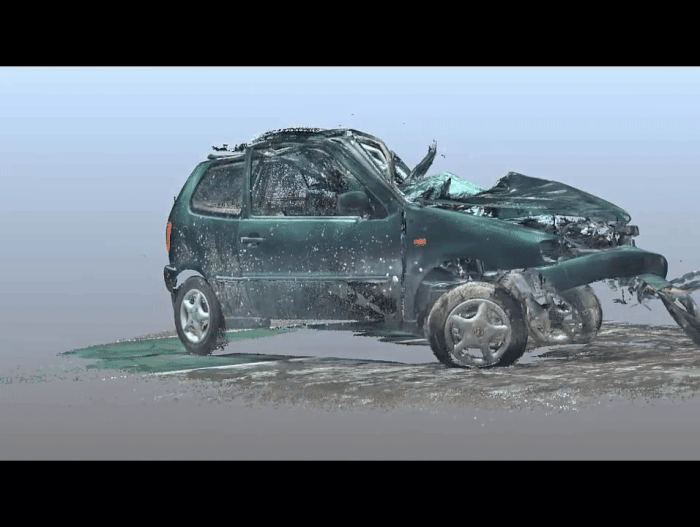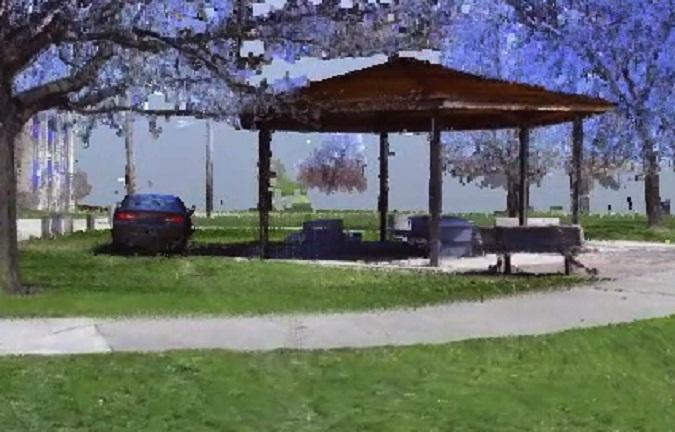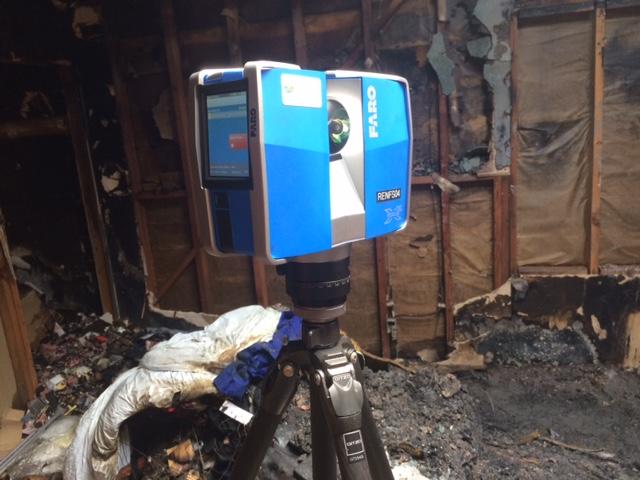Today’s 3D Virtual Reality Scanners by FARO Can Be Used to Understand and Make or Break a Courtroom Case
 While there often seems to be a euphoric, worldwide 3D printing party going on, resulting in one new gizmo after another that we can barely stand to pass up, the technology just as often stands in somber juxtaposition, serving other sectors like that of law enforcement–and dealing with the dark subject of murder.
While there often seems to be a euphoric, worldwide 3D printing party going on, resulting in one new gizmo after another that we can barely stand to pass up, the technology just as often stands in somber juxtaposition, serving other sectors like that of law enforcement–and dealing with the dark subject of murder.
After the tragic and bloody mass shooting and attempted bombing in San Bernardino last December, police were tasked with dissecting the event that resulted in 14 dead and 22 seriously injured. As they attempted to put all the pieces together, they had a high-tech tool to help them behind the scenes–unbeknownst to most of the public–in the form of 3D laser scanners from tech company FARO. Today, putting these tools on the scene directly after such an event allows law enforcement and their forensics departments to retain nearly every detail of a crime scene, permanently.
 For an extreme situation like San Bernardino, the scanners played a huge part in documenting more than one crime area, to also include the final area of the standoff with perpetrators Syed Rizwan Faroo and Tashfeen Malik at their vehicle. Police marked hundreds of pieces of evidence from the case at the Inland Regional Center, and around the car, filled with bulletholes.
For an extreme situation like San Bernardino, the scanners played a huge part in documenting more than one crime area, to also include the final area of the standoff with perpetrators Syed Rizwan Faroo and Tashfeen Malik at their vehicle. Police marked hundreds of pieces of evidence from the case at the Inland Regional Center, and around the car, filled with bulletholes.
These scanners have also been used in cases like the Tamir Rice incident. A virtual reconstruction was part of what made it possible to see what the site looked like as police officers approached the site without much information to go on. Neither Cleveland Police Officer Timothy Loehmann, who shot Rice on Nov. 22, 2014, was charged, nor was Officer Frank Garmback, who was driving the patrol car. The technology has also been used in cases like that of the slaying of New York City officer Randolph Holder who was gunned down on the very streets he protected.
While news of these devices and their uses are just becoming more predominant, they have been around since 2009–and since then, the Federal Bureau of Investigation, the Department of Justice and the Department of Homeland Security have invested nearly $1 million in FARO scanners, and the Department of Defense has spent $18 million. These tools have been used to help in many high profile cases lately involving shootings.
It’s quite impressive to think of how much time must have been spent collecting and inspecting evidence previously, when with the FARO 3D scanners, they can now use one 15-minute scan to document the evidence, no longer racing the clock.
Law enforcement officials record the crimes by using the scanner in a manner very similar to a traditional camera. It is placed on a tripod in a central area of the crime scene. It takes a comprehensive scan of the area, vertically, and spinning 360 degrees, capturing virtually everything.

Virtual reconstructions featured in some of last year’s biggest shooting cases, including the Tamir Rice incident. (Photo by FARO Technologies)
“It is the most complete documentation tool, aside from digging up the house and bringing the entire house with me,” said Russ, who is a crime scene specialist with San Bernardino County sheriff’s department.
Multiple vantage points can be captured as well, which is very important for a crime scene where nothing can be predicted, obviously. The scanner can even be manipulated to work underneath a car, or be placed in something like a manhole–with 14 million data points being collected from an average scan, and some scenes requiring 50 to 60 of those. Looking at that math, and the short time period required for scans, a massive amount of data can be collected and stored, combining images and offering an entire 3D picture for crime lab specialists to analyze. Traditional photos are also added to the mix.
“They’ll capture up to 1,000 feet of data in each direction, plus full color photographs, with an accuracy of 2 millimeters [seven hundredths of an inch],” said Kelly Watt, a regional manager of FARO’s forensic division.
 3D forensic reconstructionist and FARO distributor David Dustin says that their most expensive long-range model comes with a price-tag of $59,000, but they also have a less expensive handheld model in the $11,000 range. This is much less expensive, according to Dustin, who says that scanners coming from their competitors range from $150,000 to $200,000.
3D forensic reconstructionist and FARO distributor David Dustin says that their most expensive long-range model comes with a price-tag of $59,000, but they also have a less expensive handheld model in the $11,000 range. This is much less expensive, according to Dustin, who says that scanners coming from their competitors range from $150,000 to $200,000.
They also offer a comprehensive scanning product that allows for a virtual reality walk-through, allowing for zooming in and out–often used by Secret Service as they scope out an event area days before. This is also extremely helpful in a courtroom situation, allowing for details and evidence–like a bullet casing or gun–to be pointed out. Blood spatter is quickly calculated as well.
“It can figure out where a person was hit and even determine if it was a defensive wound or an aggressive attack,” Watt said. “For a collision, you can do a crush analysis. If a vehicle has been struck, we can estimate the speed of the vehicle based on crush damage and manufacture specs on the vehicle.”
Further, they are able to use the scanning equipment for virtual autopsies, which allow for the reconstruction of faces and body parts, and has been instrumental in solving cold case files.
“It’s called virtopsy or virtual autopsy. The first thing that we do is a laser scan of the body to capture bite marks, bruises and other things that we might lose when we open the body,” said Summer Decker, Director of Imaging Research at USF Health’s department of radiology. “Little ridges, bumps and holes on a surface are such important information to scientists. If we had to take a photograph then we wouldn’t be able to capture this texture.”
“We can laser scan the skulls in question, 3D print the faces and then have families identify the faces in the 3D model,” Decker said. “Or we can look at the surface of pubic symphysis — the area where the two parts of the pelvis intersect in the front — to determine someone’s age, their lifestyle or whether or not they had children if they’re a female.”
She sees this technology as becoming much more intense and capable in the near feature, envisioning headsets for juries as they are able to see into a crime scene for themselves. Decker is indeed working on a technology also with Microsoft for virtual headsets like the HoloLens.

Laser scans of a skull led to this 3D facial model and helped identify a homicide victim from a 2009 cold case. Image by Sr. Special Agent Deborah Goff, Forensic Art Unit, South Carolina Law Enforcement Division. Courtesy of Summer Decker
3D scanners are extremely important in a court of law also because of their unbiased element. It’s hard to refute a clear photo or scan, and they are also extremely as supporting evidence and material as well.
“What the scanning does is add subjectivity, and it adds clarity. It can make things much clearer for a juror so they can make a better decision,” says Eugene Liscio, a 3D forensic specialist.
These processes are not always inexpensive to come by, however, so that’s a consideration regarding who will be able to employ them, and how often. The technology and its uses have evolved greatly since FARO acquired ARAS 360, a software company, back in early 2015, with the idea of using their work in accident reconstruction and simulation.
[Source: PBS]
Subscribe to Our Email Newsletter
Stay up-to-date on all the latest news from the 3D printing industry and receive information and offers from third party vendors.
You May Also Like
3D Printing Unpeeled: New Arkema Material for HP, Saddle and Macro MEMS
A new Arkema material for MJF is said to reduce costs per part by up to 25% and have an 85% reusability ratio. HP 3D HR PA 12 S has been...
3D Printing News Briefs, January 20, 2024: FDM, LPBF, Underwater 3D Printer, Racing, & More
We’re starting off with a process certification in today’s 3D Printing News Briefs, and then moving on to research about solute trapping, laser powder bed fusion, and then moving on...
3D Printing Webinar and Event Roundup: December 3, 2023
We’ve got plenty of events and webinars coming up for you this week! Quickparts is having a Manufacturing Roadshow, America Makes is holding a Member Town Hall, Stratafest makes two...
Formnext 2023 Day Three: Slam Dunk
I’m high—high on trade show. I’ve met numerous new faces and reconnected with old friends, creating an absolutely wonderful atmosphere. The excitement is palpable over several emerging developments. The high...































